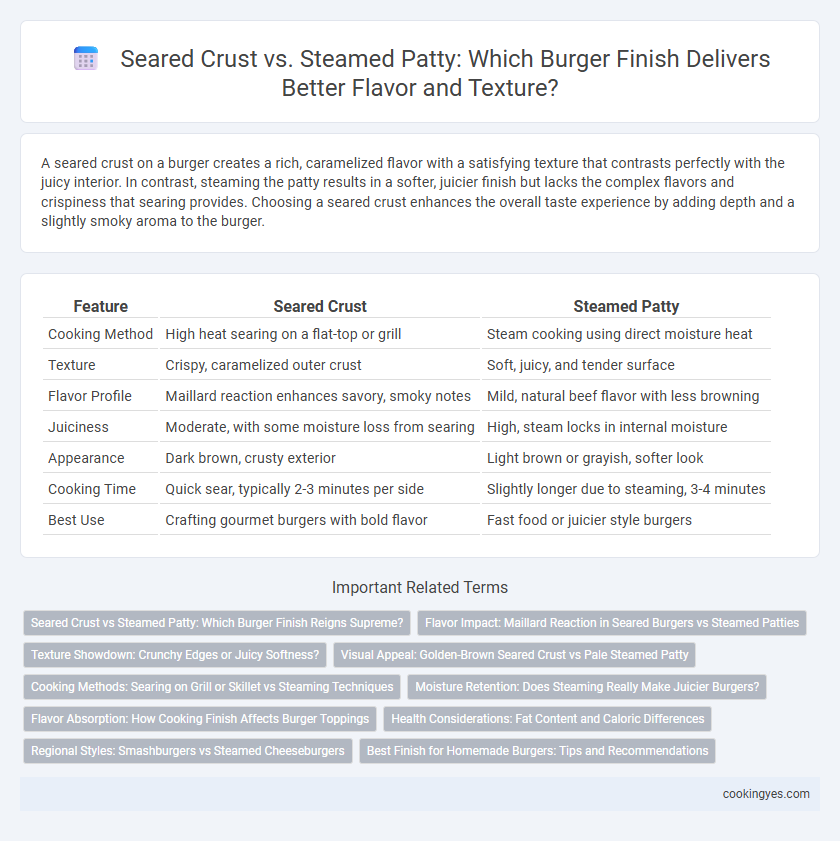A seared crust on a burger creates a rich, caramelized flavor with a satisfying texture that contrasts perfectly with the juicy interior. In contrast, steaming the patty results in a softer, juicier finish but lacks the complex flavors and crispiness that searing provides. Choosing a seared crust enhances the overall taste experience by adding depth and a slightly smoky aroma to the burger.
Table of Comparison
| Feature | Seared Crust | Steamed Patty |
|---|---|---|
| Cooking Method | High heat searing on a flat-top or grill | Steam cooking using direct moisture heat |
| Texture | Crispy, caramelized outer crust | Soft, juicy, and tender surface |
| Flavor Profile | Maillard reaction enhances savory, smoky notes | Mild, natural beef flavor with less browning |
| Juiciness | Moderate, with some moisture loss from searing | High, steam locks in internal moisture |
| Appearance | Dark brown, crusty exterior | Light brown or grayish, softer look |
| Cooking Time | Quick sear, typically 2-3 minutes per side | Slightly longer due to steaming, 3-4 minutes |
| Best Use | Crafting gourmet burgers with bold flavor | Fast food or juicier style burgers |
Seared Crust vs Steamed Patty: Which Burger Finish Reigns Supreme?
A seared crust creates a Maillard reaction, enhancing flavor with a caramelized, crispy exterior that locks in juices for a rich, savory bite. In contrast, a steamed patty offers a softer texture and juiciness, often favored in iconic styles like the In-N-Out burger, where steam intensifies moisture without browning. The seared crust typically triumphs in delivering bold taste and texture contrast, making it the preferred finish for gourmet and classic burgers.
Flavor Impact: Maillard Reaction in Seared Burgers vs Steamed Patties
Seared crust burgers develop complex flavors through the Maillard reaction, which creates a rich, caramelized exterior by browning amino acids and sugars at high heat. Steamed patties lack this intense searing process, resulting in a softer texture and a milder flavor profile without the distinctive umami notes. The Maillard reaction significantly enhances the savory depth and aroma of seared burgers compared to steamed options.
Texture Showdown: Crunchy Edges or Juicy Softness?
Seared crust creates a satisfying crunchy edge by caramelizing the Maillard reaction, enhancing both flavor and texture with a bold, crispy finish. In contrast, a steamed patty delivers juicy softness, locking in moisture for a tender bite that emphasizes succulence over crust. Choosing between these methods depends on preference for either a textured crunch or a consistently juicy experience.
Visual Appeal: Golden-Brown Seared Crust vs Pale Steamed Patty
A golden-brown seared crust creates a visually appealing burger with a crispy, caramelized exterior that signals rich flavor and texture. In contrast, a steamed patty often appears pale and lacks the enticing color contrast, which can result in a less appetizing presentation. The seared finish enhances the burger's overall aesthetic, making it more attractive and inviting to diners.
Cooking Methods: Searing on Grill or Skillet vs Steaming Techniques
Seared crust on a burger patty offers a Maillard reaction that enhances flavor through caramelization, creating a crispy, savory exterior. Steamed patties, by contrast, retain juiciness and tenderness by cooking in moist heat, preventing dryness but lacking the charred texture. Choosing searing on a grill or skillet versus steaming techniques depends on desired taste and texture profiles, with searing favored for robust, smoky flavors and steaming for moist, delicate finishes.
Moisture Retention: Does Steaming Really Make Juicier Burgers?
Seared crusts create a Maillard reaction that enhances flavor while slightly reducing moisture through evaporation. Steamed patties retain more internal moisture by cooking in a humid environment, resulting in juicier bites. However, steaming may sacrifice the crispy texture and rich aroma associated with a seared finish.
Flavor Absorption: How Cooking Finish Affects Burger Toppings
A seared crust creates a caramelized, flavorful exterior that enhances the burger's ability to hold robust toppings by providing a slightly charred, textured surface. In contrast, steamed patties tend to retain more moisture but produce a softer exterior, which can cause toppings to slide off more easily due to the lack of a firm grip. Flavor absorption is significantly influenced by the cooking finish; seared crusts lock in juices and intensify the burger's savory profile, allowing toppings like melted cheese, sauces, and grilled onions to meld more effectively.
Health Considerations: Fat Content and Caloric Differences
Seared crust burgers often have higher fat content due to the caramelization process trapping oils and juices, increasing overall calories compared to steamed patties, which retain more moisture without added fats. Steamed patties tend to have lower calorie counts and reduced fat absorption, making them a healthier option for calorie-conscious consumers. Choosing steaming over searing can significantly reduce saturated fat intake, promoting better heart health and weight management.
Regional Styles: Smashburgers vs Steamed Cheeseburgers
Seared crust smashburgers, popular in Nashville and Los Angeles, achieve a caramelized, crispy exterior by pressing the patty against a hot griddle, locking in juiciness and enhancing Maillard reaction flavors. In contrast, steamed cheeseburgers from Wisconsin use a moist heat method where the patty is steamed inside a stainless steel dome, resulting in a tender, juicy texture with melted cheese that melds seamlessly into the beef. These regional styles exemplify distinct finishing techniques that define the burger's flavor profile and mouthfeel within their culinary traditions.
Best Finish for Homemade Burgers: Tips and Recommendations
A seared crust on a homemade burger provides a flavorful, caramelized exterior that locks in juices, creating a satisfying texture contrast. Steaming the patty ensures a tender and uniformly cooked interior but may result in a less crispy finish. For the best combination, start with high heat searing to form the crust, then briefly steam or cover the patty to retain moisture, achieving a juicy burger with a perfect crust.
Seared crust vs steamed patty for burger finish Infographic

 cookingyes.com
cookingyes.com